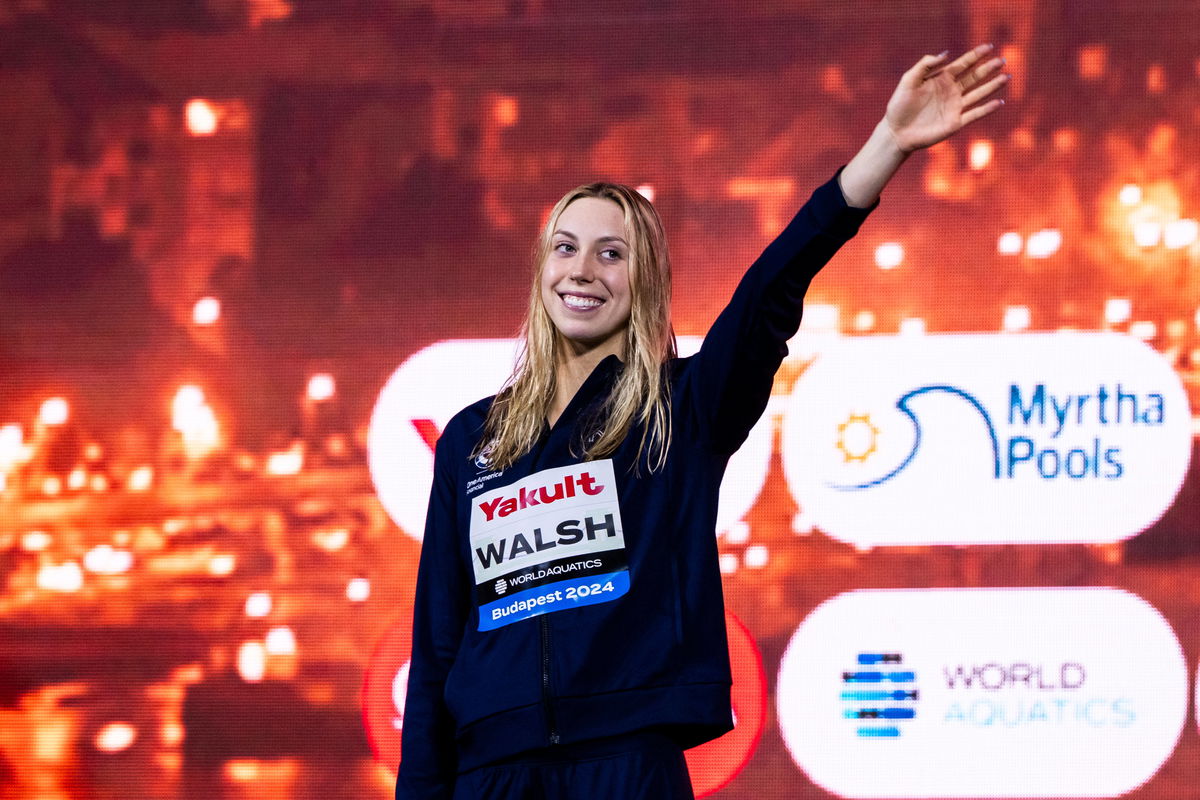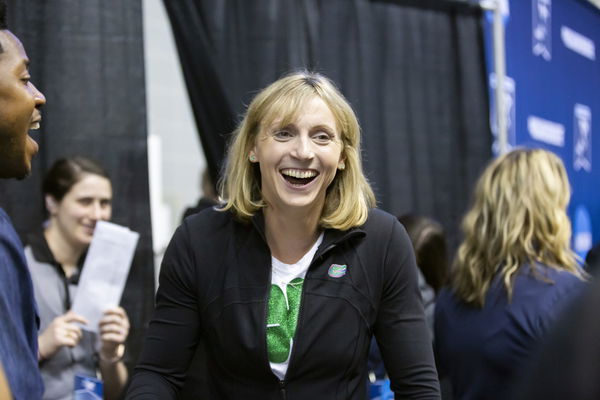
Imago
241213 Gretchen Walsh of United States celebrates during the medal ceremony after mens and womens 100 meter individual medley during day 4 of the 2024 World Aquatics Short Course Swimming Championships on December 13, 2024 in Budapest. Photo: Emma Wallskog / BILDBYRAN / COP 320 / EW0469 simning swimming svomming 2024 fina short course world swimming championships bbeng kortbane-vm World Championship, WM, Weltmeisterschaft 25m short course kortbana vm jubel *** 241213 Gretchen Walsh of United States celebrates during the medal ceremony after mens and womens 100 meter individual medley during day 4 of the 2024 World Aquatics Short Course Swimming Championships on December 13, 2024 in Budapest Photo Emma Wallskog BILDBYRAN COP 320 EW0469 swimming swimming svomming 2024 fina short course world swimming championships bbeng kortbane vm world championship 25m short course kortbana vm jubel PUBLICATIONxNOTxINxSWExNORxFINxDEN Copyright: EMMAxWALLSKOG BB241213EW061

Imago
241213 Gretchen Walsh of United States celebrates during the medal ceremony after mens and womens 100 meter individual medley during day 4 of the 2024 World Aquatics Short Course Swimming Championships on December 13, 2024 in Budapest. Photo: Emma Wallskog / BILDBYRAN / COP 320 / EW0469 simning swimming svomming 2024 fina short course world swimming championships bbeng kortbane-vm World Championship, WM, Weltmeisterschaft 25m short course kortbana vm jubel *** 241213 Gretchen Walsh of United States celebrates during the medal ceremony after mens and womens 100 meter individual medley during day 4 of the 2024 World Aquatics Short Course Swimming Championships on December 13, 2024 in Budapest Photo Emma Wallskog BILDBYRAN COP 320 EW0469 swimming swimming svomming 2024 fina short course world swimming championships bbeng kortbane vm world championship 25m short course kortbana vm jubel PUBLICATIONxNOTxINxSWExNORxFINxDEN Copyright: EMMAxWALLSKOG BB241213EW061
This summer, Gretchen Walsh’s university, the University of Virginia’s men’s swimming program received a financial windfall that has turned heads across collegiate athletics. A $2.2 million anonymous commitment, combined with university matching, brings the total impact to $2.7 million, a record-breaking figure for the program. In theory, the gift signals a renewed ambition to restore a once-proud program to national relevance. Yet for all its strategic value, the donation does not quite shift the historical balance of NCAA swimming philanthropy.
Watch What’s Trending Now!
That distinction, as those familiar with the sport’s institutional history will recall, belongs to the University of Southern California’s $8 million landmark gift in 2012.
The Virginia Athletics Foundation announced the gift would support scholarships and expand the men’s team’s recruiting capacity. Head coach Todd DeSorbo, who already presides over the most dominant women’s program in the country, now has resources that could gradually lift the men’s side from mediocrity.
ADVERTISEMENT
Despite their recent struggles, 32nd at the 2025 NCAA Championships and 8th in the ACC, UVA welcomes an unusually strong incoming class, highlighted by Olympic medalist Thomas Heilman and world junior champion Maximus Williamson. DeSorbo projected that all twelve freshmen could make the ACC squad this year. The infrastructure aligns with the talent, and optimism is reasonable. Still, the symbolic power of this new investment does not fully rival one that changed the national landscape over a decade ago.
In 2012, USC made headlines with an $8 million donation from alumnus Fred Uytengsu, a former Trojan swimmer. It remains the largest single gift to a collegiate aquatic program by a former athlete and resulted in the Uytengsu Aquatics Center, a comprehensive facility that redefined USC’s stature in the sport. The center included upgrades across the board. New diving towers, locker rooms, coaches’ offices, and a stadium accommodating 2,500 spectators. More importantly, it honored legacy.
Uytengsu named the main pool after coach Peter Daland, who led USC to nine national titles and 17 conference crowns.
ADVERTISEMENT
The donation didn’t merely add square footage. It established permanence, prestige, and a sense of continuity. In contrast, UVA’s 2025 gift, though financially significant within the program’s own context, still functions largely within a developmental frame.
And all things considered, this is not the first time a major university swimming program has benefitted from private philanthropy.
ADVERTISEMENT
In 1995, an anonymous $5 million gift funded the swimming pool for a planned Athletics Center at another institution. The contribution covered one-quarter of the required $20 million and addressed urgent competitive shortfalls. Teams were practicing off-site at a YMCA due to outdated campus facilities. The center eventually included modern gymnasiums, classrooms, and sufficient locker space to support both varsity teams and a growing recreational student population. The focus was not only athletic excellence but also infrastructural adequacy. A vision with echoes in UVA’s current trajectory.
Philanthropy in collegiate aquatics has often arrived at inflection points, and UVA now finds itself in one. While this new donation is both timely and transformative for its men’s program, history will still regard the Uytengsu gift as the more consequential benchmark. Donations of this scale do more than provide resources; they signal intent, embed legacy, and sometimes, as in USC’s case, reshape the sport’s competitive geography.
For now, UVA has momentum, but it still chases a precedent set thirteen years ago. Surely, such donations are quite important for swimming programs. After all, a lot of them have shut down due to a lack of funding.
ADVERTISEMENT
Lack of funds led to several NCAA Universities shutting down collegiate programs
Several university pools across North America now sit silent. No whistles, no splashes, no cheering from the deck. Chlorine still lingers faintly in the air, but the athletes are gone.
At Concordia University Irvine, swimmers learned their seasons had ended not with a final race but with a press release. Cal Poly followed, issuing a similarly brief notice: Their swimming and diving programs, both men’s and women’s, would cease, effective immediately. The reasoning, administrators claimed, was economic. Yet for athletes and coaches, the losses feel anything but abstract.
ADVERTISEMENT
By the 2025–26 academic year, Union Commonwealth University will also eliminate its swimming programs. The decision comes at a time when athletic departments across the country face financial recalibrations.
Top Stories
Pro Suffers Disqualification at PGA Tour Q-School After Several Players Withdrew Abruptly

2025 Vic PGA Championship: Prize Money, Winner’s Payout & More Explored

Forced to Leave FOX, Cowboys Legend Troy Aikman Says ESPN Is Like ‘U.S. Government’ & Clearly Distinguishes the Two Networks

What Disease Does Fernando Mendoza’s Mother Have? Everything To Know About Her Health Condition

Support Pours In From Phil Mickelson as ASU Football Coach Chokes Back Tears in Public

Update Announced on Josh Allen’s Bills Staying Near Brown University Amid Tragic Incident

In Concordia’s case, the trigger included rising insurance premiums. Cal Poly’s administration referenced broader fiscal pressures and anticipated payouts related to the House v. NCAA settlement. The case, expected to shift the economics of college sports, has prompted universities to weigh which programs they can afford to sustain.
Swimming, with its high overhead and modest revenue, has proven particularly vulnerable.
ADVERTISEMENT

Imago
Gretchen Walsh of United States of America reacts after competing in the 50m Freestyle Women Final during the short course World Aquatics Swimming Championships 2024 at the Duna Arena in Budapest Hungary, December 15, 2024. Gretchen Walsh placed first winning the gold medal with a new world record. AndreaXMasini
What is unfolding is not a series of isolated incidents, but a quiet unraveling. Swimming, a historically respected but financially demanding sport, is being cut not for lack of performance or participation, but because it no longer fits the budget. Even outside the United States, the trend continues.
Acadia University in Canada has closed its pool and disbanded its varsity swim team. At Notre Dame, where the men’s swimming program has been suspended for reasons including gambling concerns and NCAA violations, the tone was different, but the result was the same. Another team off the board.
ADVERTISEMENT
One by one, competitive swimming programs are being shuttered, not due to failure in the water, but from decisions made in boardrooms.
Donor dollars and NIL deals are reshaping college swimming
For many swimmers in the United States, the NCAA has long represented a critical bridge between junior promise and professional success. In the evolving landscape of collegiate swimming, financial opportunity no longer hinges solely on Olympic success or commercial appeal.
ADVERTISEMENT
For a growing number of athletes, especially those whose names do not draw national headlines, private donations to university programs have become a critical factor in shaping sustainable athletic careers. These contributions, ranging from alumni endowments to booster-backed support, have empowered swimmers to train, compete, and study with the kind of resources once reserved for revenue-heavy sports. While NIL legislation has attracted considerable attention, it is the quiet consistency of donor funding that, in many cases, provides the true foundation for upward mobility within the sport.

Getty
KNOXVILLE, TN – MARCH 17: Katie Ledecky during the Division I Womens Swimming & Diving Championships held at the Allan Jones Aquatic Center on March 17, 2023 in Knoxville, Tennessee. (Photo by Jessie Rogers/NCAA Photos via Getty Images)
Top-tier programs such as those at Virginia, Texas, and Stanford have long benefited from robust donor networks, which support everything from travel budgets to nutrition and academic assistance. These endowments do more than furnish facilities or coaching salaries. They create competitive parity.
Talented swimmers from modest backgrounds can now access the same caliber of development as those from elite swim clubs. For athletes like Erica Sullivan or Phoebe Bacon, this infrastructure is what enables long-term growth. While some may secure NIL arrangements, many more rely on the stability afforded by donor-backed systems that allow them to focus on performance rather than financial survival.
NIL has unquestionably opened new doors, particularly for athletes with Olympic credentials. Swimmers such as Lydia Jacoby and Kate Douglass have used their international profiles to secure partnerships that align with their public recognition.
But for every athlete with a headline moment, there are dozens more progressing quietly through college rosters, benefitting not from sponsorships but from scholarships and behind-the-scenes generosity. In this way, collegiate swimming’s modern ecosystem, fueled by both NIL and institutional giving, has become not a marketplace, but a platform.
ADVERTISEMENT
ADVERTISEMENT
ADVERTISEMENT

